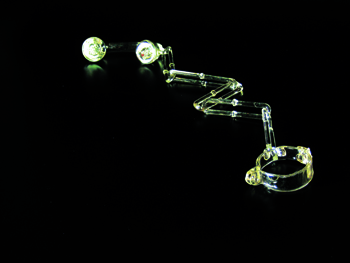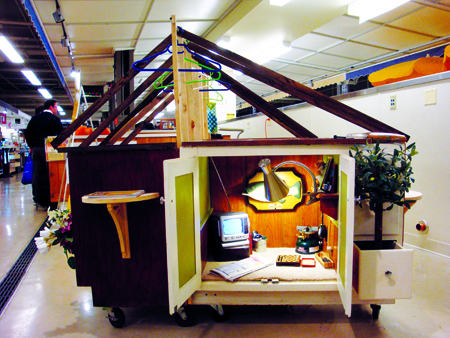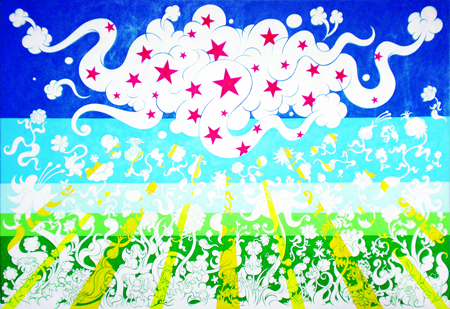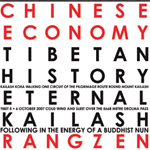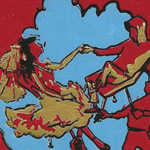Taking stock of Chicago’s first Art Loop Open
From October 15-29, artworks by 200 local artists were displayed at unlikely downtown Chicago venues such as Block 37, the Hard Rock Hotel, Macy’s, the Chicago French Market, and the Wit Hotel in the first annual Art Loop Open competition. Organized by the Chicago Artists’ Coalition and the Chicago Loop Alliance, Art Loop Open allowed anyone to vote for his or her favorite work of art by using a Smart Phone application or via text messages; winners took home generous cash prizes.
The days leading up to the competition’s close were filled with skepticism. Local art critics like Abraham Ritchie and Erik Wenzel argued that, like its sister initiative Pop-Up Art Loop, the competition was an obvious attempt to promote struggling downtown businesses with a glitzy, reality TV-type art event, making the art secondary to the commerce. Others complained that Art Loop Open was little more than a popularity contest: The artist who has the most friends to vote for him or her wins. Then, there was major controversy when artist Bernard Williams was disqualified from the competition for allegedly promoting his art in a way that broke the rules — only to be suddenly reinstated shortly before voting ended.
Now that the prizes have been handed out, what’s the final consensus on the competition’s impact on the Chicago art scene?
Chicago Artists’ Coalition executive director Carolina O. Jayaram said Art Loop Open was different from other art competitions, like ArtPrize in Grand Rapids, because all exhibiting artists had to be locally based and because their work was chosen by a jury that included highly regarded professionals, like SAIC Executive Director of Exhibitions and Events, Mary Jane Jacob.
“We had a program here for 12 years called the Art Open that Chicago Artists’ Coalition had done that was open to all artists. …. It was a nice model for the years that it lasted; but I think that it was outdated and needed to be reinvented — and this idea of just hanging everybody together without any rhyme or reason, I didn’t believe was doing anybody a service,” said Jayaram. This year, the selected art was curated and hung in the ten participating venues by a production team that included curators like Shannon Stratton, who teaches at SAIC and runs threewalls gallery.
According to Jayaram, the inaugural Art Loop Open sought to address one of her main concerns in the Chicago arts community: audience building. By teaming with the Chicago Loop Alliance and installing work for sale in high-traffic hotel lobbies and in shopping malls, Jayaram hoped to increase the number of local art supporters and collectors, even if that meant soliciting shoppers, tourists, and passersby to look at, vote for, and hopefully buy art that they might not otherwise have been exposed to.
The three top winners of the competition, John Dempsey, Daniel Lavitt, and Joseph Ivacic, won cash prizes of $25,000, $15,000, and $10,000, respectively. The artists admit, however, that the venue in which their work was shown was just as important to their success as the art itself.
Ivacic, whose glass-blown sculpture “Staying Connected” was shown at the Burnham Hotel, saw the layout of the venues and how the work was installed as problematic for the voting process. “Some of the work, depending on where it was shown, kind of got looked over, because some of the venues either weren’t around the same area, or they weren’t specific about where the work was showing,” he said, noting that the art works installed in the Palmer House in particular were spread out and poorly lit.
On the other hand, “By having the work in these different venues, you are definitely showing the work to a different audience,” he said. “I’m not so sure it’s a completely educated audience, but it’s very different.”
Jayaram recognizes that exhibiting the work at unconventional locations was a challenge not only for the audience, but also for the curators and the artists. Like critics of the competition, she compared it to a “reality show,” especially with regards to the task of curating in such commercial spaces.
“In some ways, people were unhappy about how things were exhibited because of lighting or whatever, but that’s really hard to control because it’s one of those things that you have to take the good thing with the bad. If you’re [showing work] in the Hard Rock Hotel, that’s a dark lobby,” she said. “We’re not going to ask them to bring in a bunch of lights and change the whole look of the lobby. But at the same time, you’re going to be in a place full of people who would never normally see your work, so it’s a trade-off.”
Lavitt, a graduate of SAIC (MFA ’09), remembers feeling disappointed when he first learned that his work, “Till We Meet Again,” wouldn’t be shown at Block 37, the location that he felt was the focal point of the exhibition. But he realized during the competition that his venue at the Chicago French Market within MetraMarket (located in the West Loop’s Ogilvie train station) worked in his favor. “Whereas originally I thought that [the French Market] would hurt my chances because people wouldn’t take the time to go there, the people who were naturally there were just willing to vote for me,” Lavitt said, noting that his audience included vendors who worked at the French Market and customers who were buying meat and vegetables.
Lavitt recalled that questions like “Are you a new vendor here?” and “Are you selling flowers?” were common among his viewers, who often mistook his sculptural installation of cabinets on wheels as a new kiosk in the market. Whereas Lavitt was enthusiastic about literally peddling himself and his artwork to his audience at the French Market, he said that he would have felt embarrassed doing so if his piece was at Block 37, which felt sterile and pristine. “But at the French Market, there’s this hustle, steam from pots and weird fresh fish right next to me, that it seemed like it was part of the vibe of the whole place to be like, ‘Hi, I’m participating in this contest, would you like to check out my work?’”
For Lavitt, promoting his work at the French Market became a full-time job; he was unemployed at the time, and said he was”desperate for money, and it seemed like a possible way to make money.” He says that the competition felt like “the perfect storm,” whereas if he produced the same piece next year, he doesn’t know if it would win.
Dempsey (whose painting, “The Great American Landscape,” won first prize) also felt that he benefitted from his location. There were only three other artists exhibiting in Macy’s with him, whereas locations like Block 37 contained over 80 works of art. “I thought it was going to be a bad location, but at lunchtime it was packed with people,” he said, adding that the biggest problem in his venue was the lack of cell phone service in certain areas. Like Ivacic and Lavitt, Dempsey also spent time standing in front of his work, and was able to direct texting voters towards the window, where the reception was better.
During the two weeks of the competition, Dempsey would take breaks from painting at his West Loop studio and visit Macy’s to encourage votes from the lunchtime crowd. “As an artist, you want to be in your studio painting, you don’t want to be going around trying to get people to vote for you,” he said. On the other hand, he added, one of the best parts of the competition was the opportunity to meet and network with other exhibiting artists.
And while most artists would agree that they’d rather be making art than asking strangers for votes at a shopping center or a hotel lobby, it’s exactly this type of self-promotion that has afforded the three prizewinners the time to devote to their artwork and the publicity of the competition. Lavitt looks forward to paying off years of credit card debt and finally buying an iPhone and health insurance. Dempsey’s prize money will go towards daycare for his newborn and staying in his Fulton Market studio for a few more years. Ivacic says the money allows him the freedom to turn down commissions and exhibitions he doesn’t feel are appropriate, and to work with smaller groups of students at Chicago Hot Glass, where he teaches.

